The release of the new Focus Issue of the Astrophysical Journal Letters yesterday highlights the results related to the gamma-ray burst GRB 221009A, which is considered the brightest gamma-ray burst of all time. The issue features a series of articles that delve into the details of this remarkable event, with some articles already published and others in press.
The articles in this issue cover a range of topics related to GRB 221009A, including its physical properties, the nature of the burst itself, and the possible implications of this event for our understanding of the universe. These articles are written by leading experts in the field of astrophysics and offer a valuable contribution to the ongoing study of gamma-ray bursts and other enigmatic events in the cosmos.
Overall, the new Focus Issue of the Astrophysical Journal Letters represents an important development in the study of gamma-ray bursts and their properties. By continuing to study and understand these events, scientists and researchers can gain new insights into the workings of the universe and our place within it.
A SUPERLATIVE BURST
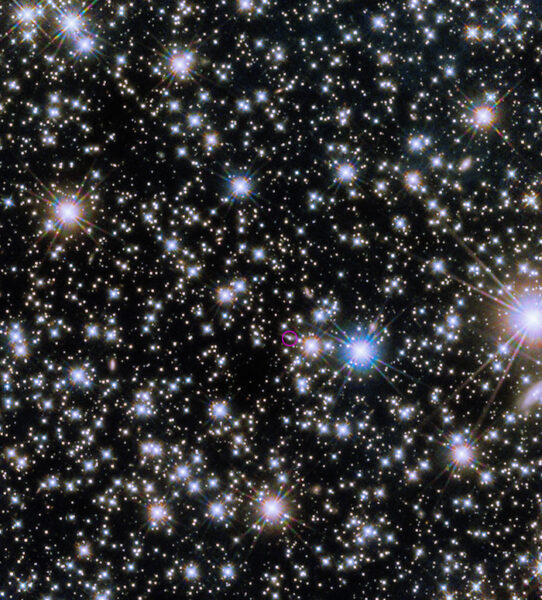
Gamma-ray bursts, like the remarkable event GRB 221009A, are brief flashes of high-energy emission that last anywhere from a fraction of a second to several hours. They are thought to arise from various astrophysical phenomena, such as the collision of two compact stellar remnants called neutron stars or the collapse of a massive, rapidly spinning star to form a black hole.
GRB 221009A, which was detected on October 9, 2022, was an exceptionally bright and long-lived burst that was picked up by 25 satellites, including some that were not designed to detect gamma-ray bursts. The burst even had an impact on Earth’s atmosphere, creating a disturbance as large as a solar flare would.
GRB 221009A ACROSS THE ELECTROMAGNETIC SPECTRUM
An article led by Maia Williams of Pennsylvania State University describes the initial discovery and properties of GRB 221009A. The analysis of the burst’s emission suggests that the jet it produced was extremely narrow, but the afterglow emission is not well-fit by some of the standard models for how the emission is produced. This suggests that further work is needed to fully understand this remarkable event.
Overall, the study of gamma-ray bursts and other enigmatic events in the cosmos remains a critical area of research in astronomy and astrophysics. By continuing to study and understand these events, scientists and researchers can gain new insights into the workings of the universe and our place within it.
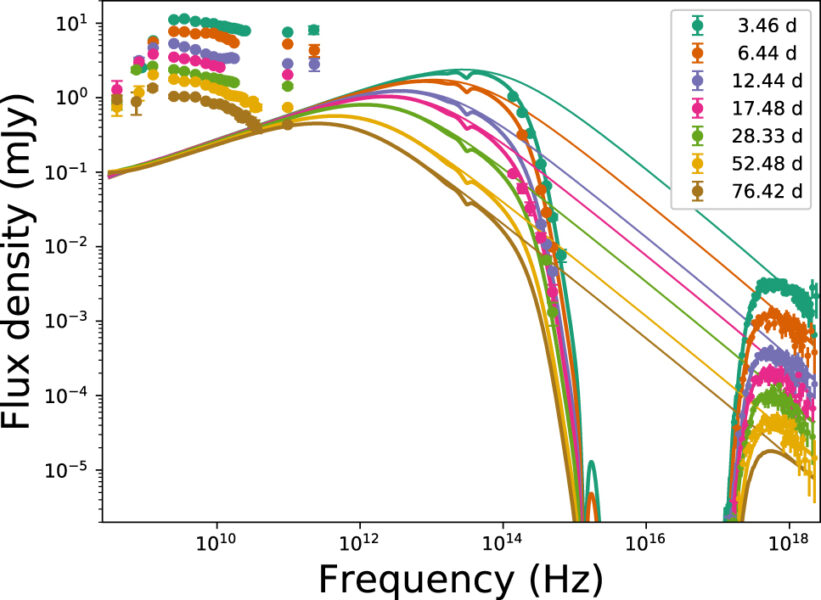
Following the discovery of GRB 221009A, astronomers monitored the event at wavelengths across the electromagnetic spectrum to better understand its properties. Researchers from the University of Utah, led by Tanmoy Laskar, studied the burst’s behavior from radio to gamma rays and found evidence for a shock forming where the gamma-ray burst’s jet collides with surrounding material. The team noted that the radio emission should linger for years, providing further opportunities to study this event.
In addition to space-based gamma-ray telescopes, researchers used the High Energy Stereoscopic System (HESS), a set of five telescopes located in Namibia, to search for emission linked to GRB 221009A. Although they found none, the upper limits derived from the observations allowed the HESS team to constrain the possible emission mechanism for the burst.
David Kann from Goethe University Frankfurt and collaborators presented optical and X-ray data spanning from the prompt phase of the burst out to 60 days post-burst. The team used these observations to study the dust along the path between the burst and Earth, finding that the burst’s host galaxy is probably moderately dusty. Modeling of the burst’s jet presented some curiosities, with the simplest jet model failing to reproduce the observations and adding structure and other features to the jet not improving the fit.
Overall, the study of GRB 221009A highlights the complexity and diversity of gamma-ray bursts and their properties. By continuing to study and understand these events, scientists and researchers can gain new insights into the workings of the universe and our place within it.
SUPERNOVA OR NO?
One of the intriguing features of the evolution of GRB 221009A is that it might not show any supernova emission. While gamma-ray bursts are often accompanied by a supernova, powered by nuclear reactions within the material expelled as the star collapses, the emission from the burst fades while the emission from the supernova brightens, eventually peeking out from beneath the fading afterglow as a bump in the light curve days or weeks after the onset of the burst.
However, as of yet, there is no evidence of any supernova emission associated with GRB 221009A. This raises interesting questions about the nature and properties of this event and underscores the complexity of studying gamma-ray bursts and their associated phenomena.
Overall, the ongoing study of gamma-ray bursts and their properties remains a critical area of research in astrophysics. By continuing to study and understand these events, scientists and researchers can gain new insights into the workings of the universe and our place within it.
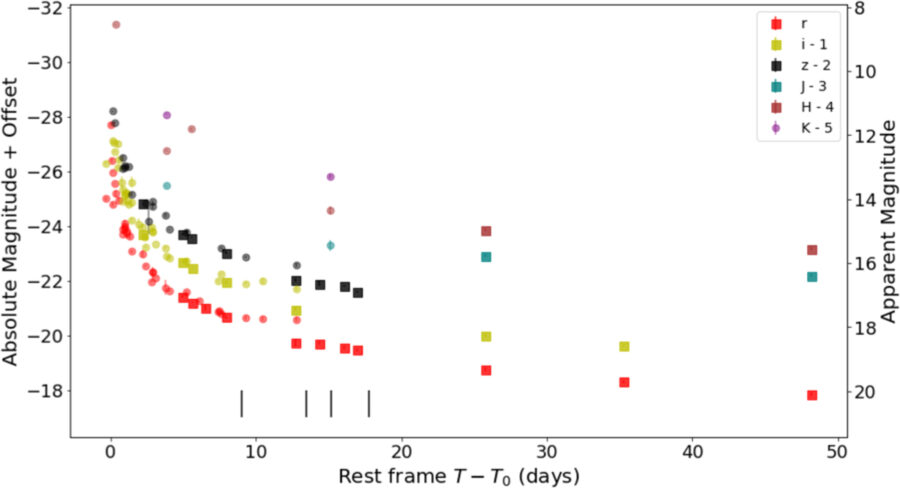
Manisha Shrestha from the University of Arizona and collaborators examined GRB 221009A’s light curves and spectra for signs of a supernova but did not find a convincing supernova signal in either. However, their modeling suggested that a supernova could be hidden beneath the bright afterglow, depending on how much the host galaxy’s dust stifles the light from the supernova. Michael Fulton from Queen’s University Belfast and coauthors monitored the burst at optical wavelengths as it faded over the course of nearly two months, finding a potential but inconclusive supernova bump around 20 days after the burst.
Andrew Levan from Radboud University and collaborators used two exceptional telescopes, the Hubble Space Telescope and the James Webb Space Telescope (JWST), and obtained the first mid-infrared spectrum ever taken of a gamma-ray burst. These observations suggest that if there is a supernova accompanying the burst, it’s faint or its spectrum peaks at wavelengths bluer than those covered by JWST and Hubble. Future work will help to disentangle the emission from the gamma-ray burst afterglow, the possible accompanying supernova, and the gamma-ray burst host galaxy that is visible in the Hubble images.
If GRB 221009A occurred without a supernova, it could mean that the newly formed black hole swallowed the debris of the exploded star, or it could mean, although the team deems this unlikely, that GRB 221009A was instead caused by the merger of neutron stars. These findings underscore the complexity and diversity of gamma-ray bursts and their properties and highlight the ongoing work needed to fully understand these enigmatic events in the cosmos.
POLARIZATION, PARTICLES, AND DUSTY PATHWAYS
A team led by Michela Negro from the University of Maryland, Baltimore County observed GRB 221009A with the Imaging X-ray Polarimetry Explorer, obtaining the first measurement of polarized X-rays from a gamma-ray burst afterglow. The observations revealed a bright central core of emission surrounded by rings created by photons scattering off of dust grains, allowing the team to study the prompt emission (in echo form) and the afterglow simultaneously.
The team placed an upper limit on the polarization fraction of 13.8% for the afterglow emission and somewhere between 55% and 82% for the prompt emission. These findings provide new insights into the nature and properties of gamma-ray bursts and their associated phenomena, and highlight the ongoing work needed to fully understand these remarkable events in the cosmos.
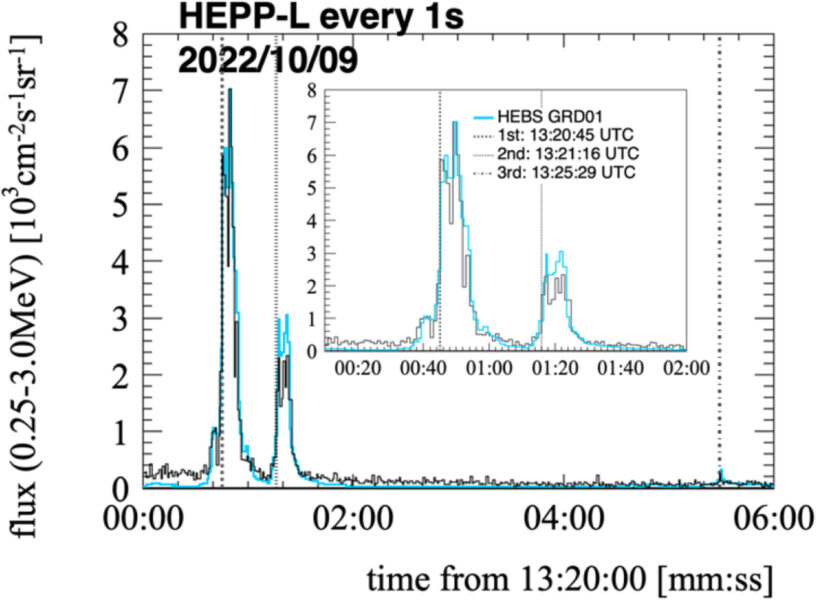
High-energy radiation from a gamma-ray burst can produce a significant increase in the ionization of Earth’s upper atmosphere. Some of these newly formed ions can be detected by spacecraft, yielding another way to study gamma-ray bursts as they happen. Robert Battison from the University of Trento and collaborators presented data from the High-Energy Particle Package on the China Seismo-Electromagnetic Satellite, which shows a sudden increase in the flux of charged particles at the time of the gamma-ray burst.
The IceCube Collaboration also searched for particles associated with the burst, but neutrinos, chargeless and nearly massless particles produced in a variety of high-energy astronomical phenomena, proved elusive. The link between neutrinos and gamma-ray bursts is theorized but yet to be proven, and the team detected no neutrinos from the event. Planned upgrades to the IceCube Neutrino Observatory might allow us to detect neutrinos, if present, from future gamma-ray bursts.
To reach us on Earth, emission from GRB 221009A had to carve a path through the Milky Way. As the narrow beam of emission pierced our galaxy, it illuminated dust clouds along its path like the beam of a flashlight. Researchers observed shifting rings of X-ray emission for weeks after the event, showing where X-rays had scattered off of dust clouds within the Milky Way. Andrea Tiengo from IUSS – School for Advanced Studies and National Institute of Astrophysics, Italy, and collaborators reported the detection of 20 such rings, corresponding to echoes off dust clouds located 1,000–61,000 light-years from Earth.
These observations and measurements demonstrate the complex and diverse nature of gamma-ray bursts and their associated phenomena, highlighting the ongoing work needed to fully understand these enigmatic events and their implications for our understanding of the universe.
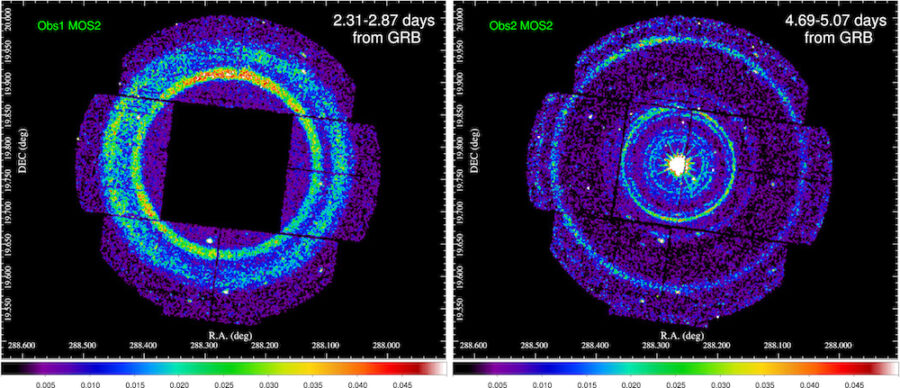
BRIGHTEST OF ALL TIME… SO FAR
GRB 221009A has been referred to as the BOAT or the Brightest Of All Time since its discovery. In a recent study, Eric Burns from Louisiana State University and collaborators explored whether this moniker is truly deserved. By comparing against decades of gamma-ray burst observations, the team found that GRB 221009A indeed had by far the highest peak flux of any gamma-ray burst measured to date, and it topped the list for two out of the remaining three measures of brightness.
Looking more closely at the properties of events observed over the past 50 years, the team estimated that GRB 221009A is a once-in-ten-millennia event. So while GRB 221009A is not the brightest gamma-ray burst in the history and future of the universe, it’s probably the brightest burst in the history of human civilization. Its rarity means that we’re lucky it happened while we have working gamma-ray telescopes.
Over the past few months, GRB 221009A has been hidden from view, blocked by the Sun’s disk. Soon, though, its reemergence will give researchers the chance to study it further and hopefully solve some of the lingering mysteries about its evolution. These ongoing studies and observations demonstrate the importance of continued research into gamma-ray bursts and their properties, as they offer unique insights into the workings of the universe and the most extreme phenomena that occur within it.
BONUS
You can view a recording of the GRB 221009A press conference that was presented yesterday at the 20th meeting of the High Energy Astrophysics Division in addition to the Focus Issue pieces that were published yesterday and those that are still to be published.








